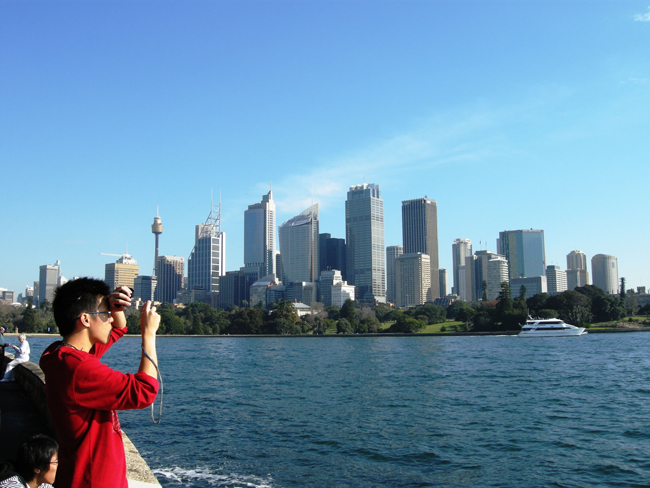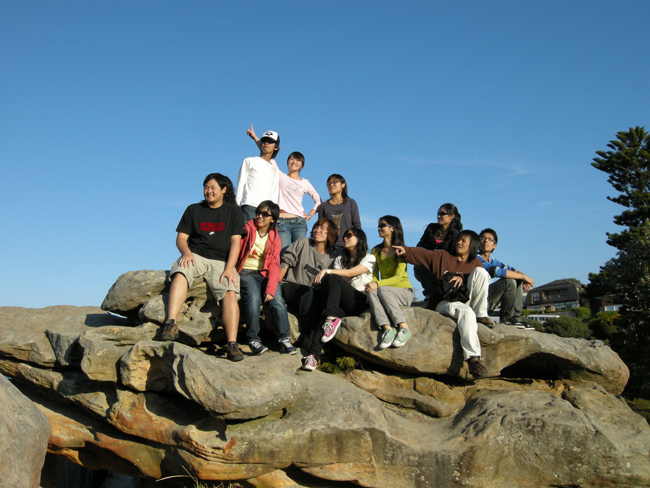Introduction to Australia
Australia
Australia belongs to the Oceania continent, between the Indian Ocean and the South Pacific Ocean. With a total area of 7,686,850 km2, it is the smallest continent but the sixth-largest country in the world. Aboriginal settlers arrived on the continent from Southeast Asia about 40,000 years before the first Europeans began exploration in the 17th century. No formal territorial claims were made until 1770, when Captain James Cook took possession in the name of Great Britain. Six colonies were created in the late 18th and 19th centuries; they federated and became the Commonwealth of Australia in 1901. The new country took advantage of its natural resources to rapidly develop agricultural and manufacturing industries and allied with Britain in World Wars I and II. In recent decades, Australia has transformed itself into an internationally competitive, advanced market economy. It is one of the OECD's fastest growing economies during the 1990s subsequent to economic reforms in the 1980s. Per capita GDP in 2007 is US$43,312 compared to US$29,650 for Hong Kong.

Australia is made up of 6 states and 2 territories. The six states are New South Wales, Queensland, South Australia, Tasmania, Victoria and Western Australia; while the two territories are Australian Capital Territory (ACT) and Northern Territory. Australia is generally arid to semiarid, experiencing a temperate climate in the south and east, and a tropical climate in the north. The country is dominated mostly by low plateaus and deserts while fertile plains are found in the southeast. Owing to the dry climate condition and long history of geomorphic processes, fertile agricultural lands constitute only 6.15% of the total land area. The present population is just over 21 million, and 60% of them concentrated in and around the mainland state capitals of Sydney, Melbourne, Brisbane, Perth, and Adelaide. Nearly 70% of the population is Catholics and Christians, and English is the official language. The capital city is Canberra, located in the ACT.
Australia is facing many environmental problems, including soil erosion from overgrazing, poor farming practices and infrastructure construction; rising soil salinity due to the use of poor quality water; desertification; the loss of biodiversity resulting from clearance of lands for agricultural purposes; and limited freshwater resources. The Great Barrier Reef off the northeast coast, the largest coral reef in the world, is threatened by increased shipping and rapid tourism development. Long-term concerns include climate-change issues such as depletion of the ozone layer, more frequent droughts and management and conservation of coastal areas, especially the Great Barrier Reef.

Map of Australia (source:http://www.lonelyplanet.com/maps/pacific/australia/)
Cairns
Cairns is a regional city and Local Government Area in Queensland, at latitude 16o55’S and longitude 145o46’E. It is located on the east coast of Cape York Peninsula on a coastal strip between the Coral Sea and the Great Dividing Range. It was settled in 1876, and named after the then Governor of Queensland William Wellington Cairns to serve miners heading for the Hodgkinson River goldfield. It developed gradually into a rail hub and major port for the exportation of sugar cane, gold, precious metals and agricultural produce from the surrounding coastal and Tableland regions. With a population of 122,731 in 2006, the city is now reliant on the sugar and tourism industries. Cairns is a regional centre for heritage tourism and there are about 0.8-1.0 million visitors annually within the last decade.

It is a popular travel destination for foreign tourists because of its tropical climate and proximity to two world heritage areas, namely the Great Barrier Reef and Wet Tropics of Queensland. The Great Barrier Reef can be reached in less than an hour by boat while the Daintree National Park and Cape Tribulation, about 130 km north of Cairns, are popular areas for experiencing a tropical rainforest. It is also a starting point for people wanting to explore Cooktown, Cape York Peninsula, and the Atherton Tableland. Cairns has used its natural surroundings to its advantage with the construction of several small theme parks for tourists. Among them are Rainforestation Nature Park, the Tjapukai Aboriginal Cultural Park and the Kuranda Skyrail Gondola Cableway, which extends for 7.5 km over World Heritage rainforest. Indeed, tourism plays a major part in the Cairns economy. It is the 4th most popular destination for international tourists in Australia, after Sydney, Melbourne and Brisbane. Although the city does not rank amongst Australia’s top 10 destinations for domestic tourism, it attracts many Australian holiday makers given its distance from major capitals. The city contains hundreds of hotels, resorts, motels and backpackers hostels. Activities in the region include golf, snorkelling, diving and hiking.
Sydney
Sydney is the most populous and famous city in Australia and sprawls over about 1800 km2 of land. It is the state capital of New South Wales.
It has a great historical significance of Australia. It is the origin of European settlement on the continent of Australasia. On 26th January, 1788, Arthur Philip from the Great Britain, who was the leader of the First Fleet, landed on a site (Nowadays called The Rocks) next to the Port Jackson and established the British colony here. He named the cove where the site next to after the British Home Secretary, Thomas Townshend, Lord Sydney, in recognition of Sydney's role in issuing the charter authorising Phillip to establish a colony.
Sydney is a city with dense population and diverse population origin. The 2006 census reported 4,119,190 residents in the Sydney Statistical Division, of which 3,641,422 lived in Sydney's urban area. Inner Sydney was the most densely populated place in Australia with 4,023 persons per square kilometre. In the 2006 census, the most common self-described ancestries identified for Sydney residents were Australian, English, Irish, Scottish and Chinese. The Census also recorded that one per cent of Sydney's population identified as being of indigenous origin and 31.7 per cent were born overseas. The three major sources of immigrants are the United Kingdom, China and New Zealand. Significant numbers of immigrants also came from Vietnam, Lebanon, Italy, India and the Philippines. Most Sydneysiders are native speakers of English; many have a second language, the most common being Arabic (predominately Lebanese), Chinese languages (mostly Mandarin or Cantonese), and Italian.[48] Sydney has the seventh largest percentage of a foreign born population in the world, ahead of cities such as the highly multicultural London and Paris.[52]
- The port has developed from the harbour into a sprawling urban agglomeration;
- It is a nodal point of the road and rail network;
- It represents the largest manufacturing center in NSW and Australia, and this means a large population of industrial and factory workers;
- It is also a leader in tertiary and service industries (finance, banking, insurance, IT, etc.);
- Recently, Sydney, along with Melbourne, have become more ethnically diverse;
- As a result, there has been the emergence of new ethnic geographies by developing distinctive ‘enclaves’. Notable examples are the Chinatown and Vietnam Town.
|